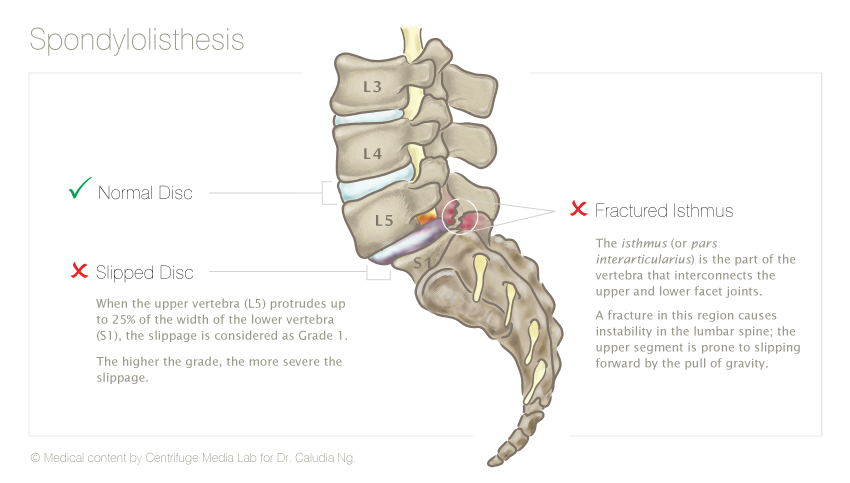Spondylolisthesis is the slippage of a vertebra over the one below it. The most common types are isthmic (occurring in the young) and degenerative (occurring in older individuals). The isthmic type is due to either a stress fracture (spondylolysis) or an elongation of the pars interarticularis. It occurs frequently in gymnasts and other sports that require hyper-extension of the spine.
Spondylolisthesis is graded from 1 to 4 depending on the amount of slippage. Grade 1 means the vertebra above is slipped forward within one quarter of the width of the vertebra below; a grade 4 means the vertebra above has slipped forward more than three-quarters of the width of the vertebra below.
Usually grade 1 spondylolisthesis is asymptomatic and stable. The incidence of low back pain in people with spondylolisthesis is the same as normal. Although progression is rare, varying degrees of facet irritation or even nerve impingement may occur. Symptoms may vary from low back pain to sciatica (pain, numbness or tingling down the leg).
What causes spondylolisthesis?
Spondylolisthesis is caused by inability of the degenerated or fractured facet joint to stabilize the vertebra above, which tends to slip forward during weight-bearing. The most common level at which this occurs is at L5/S1, where the stress from the body's weight is most concentrated.

What is the chiropractic treatment approach for spondylolisthesis?
Grade 1 and 2 spondylolistheses are considered stable and respond well to chiropractic manipulative therapy. Grade 3 or 4 cases that are symptomatic and unstable may require surgical consultation. A lumbar support brace also improves stability of the low back. As with other causes of low back pain, strengthening weak muscles is also essential in the management of spondylolisthesis.
* A proper diagnosis has to be obtained for all of the above conditions before an appropriate combination of treatments will be provided. This is just a list of possible treatments for the individual condition but not all of them may be necessary, nor is it limited to those listed only.


